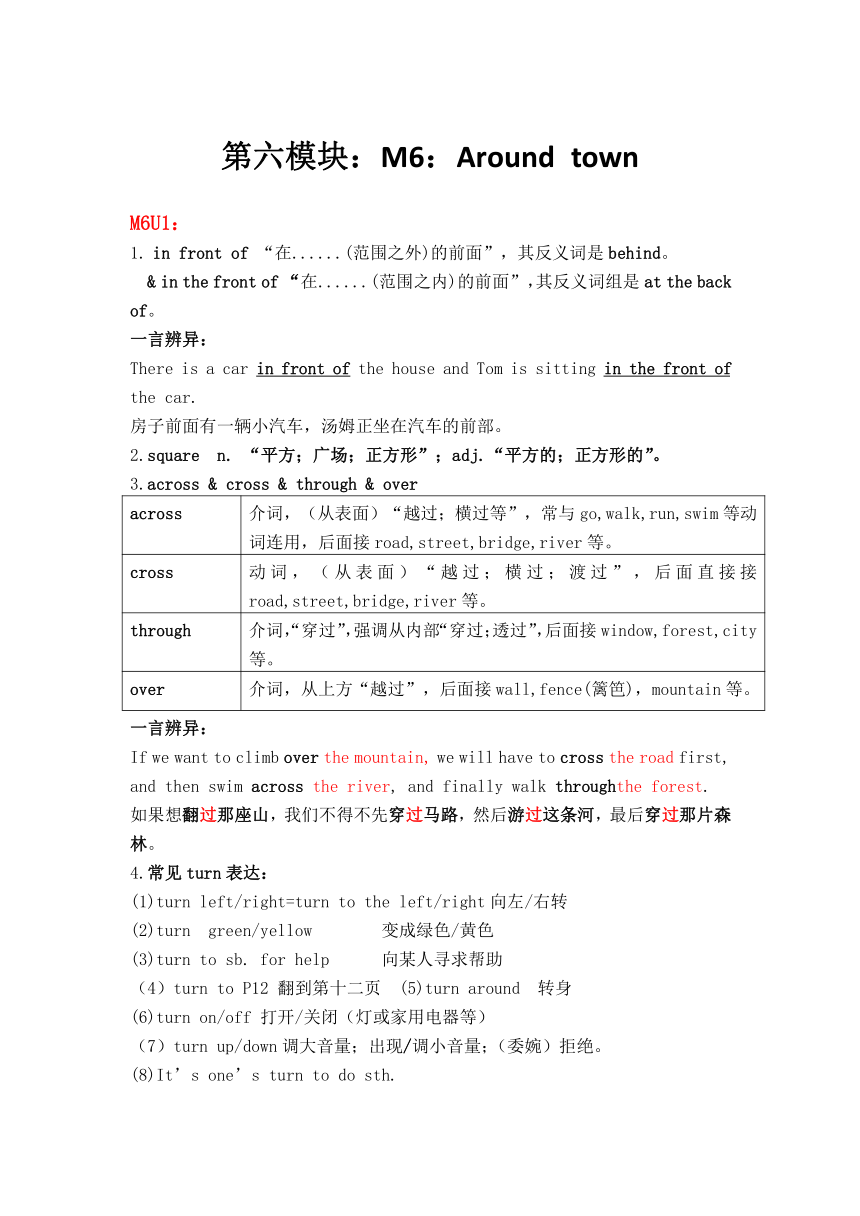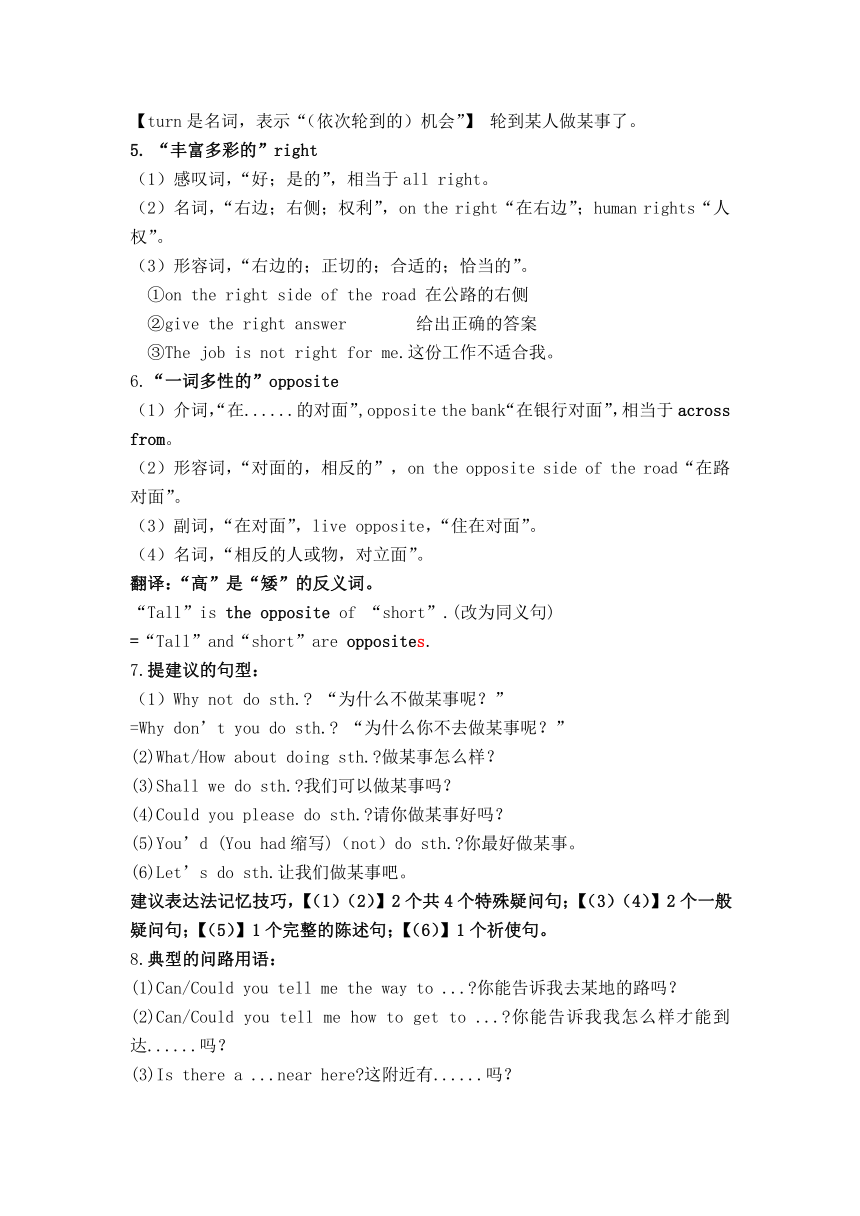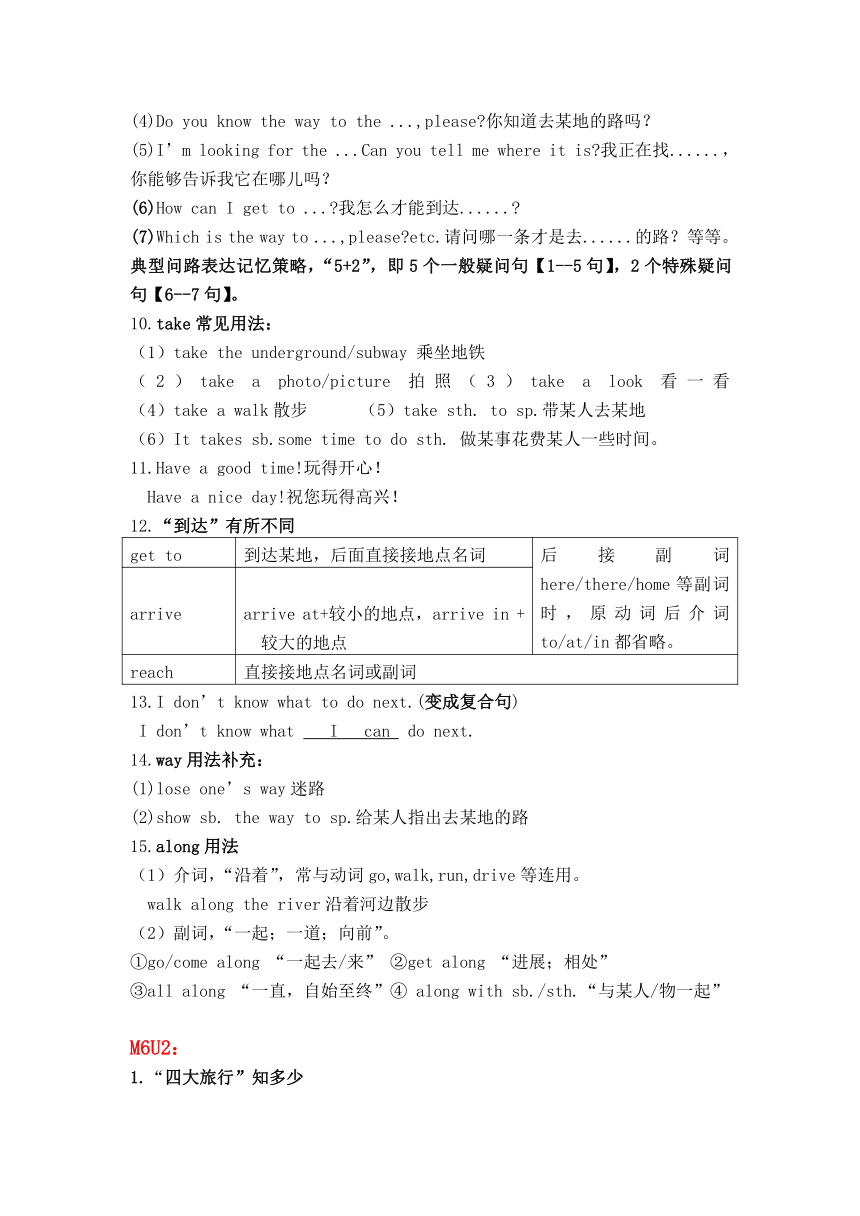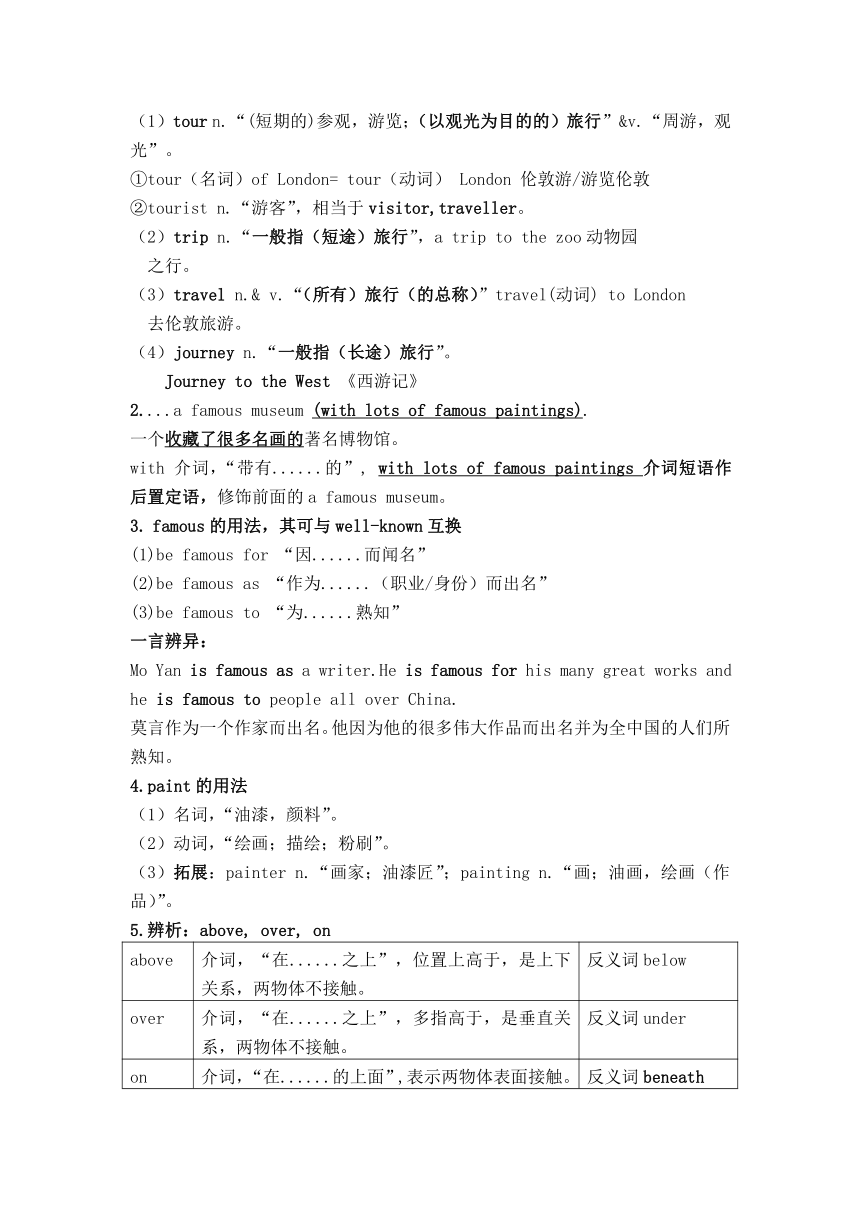外研版英语七下第六模块Module 6 Around town重要知识点
文档属性
| 名称 | 外研版英语七下第六模块Module 6 Around town重要知识点 |  | |
| 格式 | zip | ||
| 文件大小 | 71.0KB | ||
| 资源类型 | 教案 | ||
| 版本资源 | 外研版 | ||
| 科目 | 英语 | ||
| 更新时间 | 2020-05-23 19:53:06 | ||
图片预览




文档简介
第六模块:M6:Around town
M6U1:
in front of “在......(范围之外)的前面”,其反义词是behind。
& in the front of “在......(范围之内)的前面”,其反义词组是at the back of。
一言辨异:
There is a car in front of the house and Tom is sitting in the front of the car.
房子前面有一辆小汽车,汤姆正坐在汽车的前部。
2.square n. “平方;广场;正方形”;adj.“平方的;正方形的”。
3.across & cross & through & over
across 介词,(从表面)“越过;横过等”,常与go,walk,run,swim等动词连用,后面接road,street,bridge,river等。
cross 动词,(从表面)“越过;横过;渡过”,后面直接接road,street,bridge,river等。
through 介词,“穿过”,强调从内部“穿过;透过”,后面接window,forest,city等。
over 介词,从上方“越过”,后面接wall,fence(篱笆),mountain等。
一言辨异:
If we want to climb over the mountain, we will have to cross the road first, and then swim across the river, and finally walk throughthe forest.
如果想翻过那座山,我们不得不先穿过马路,然后游过这条河,最后穿过那片森林。
4.常见turn表达:
(1)turn left/right=turn to the left/right向左/右转
(2)turn green/yellow 变成绿色/黄色
(3)turn to sb. for help 向某人寻求帮助
(4)turn to P12 翻到第十二页 (5)turn around 转身
(6)turn on/off 打开/关闭(灯或家用电器等)
(7)turn up/down调大音量;出现/调小音量;(委婉)拒绝。
(8)It’s one’s turn to do sth.
【turn是名词,表示“(依次轮到的)机会”】 轮到某人做某事了。
“丰富多彩的”right
感叹词,“好;是的”,相当于all right。
名词,“右边;右侧;权利”,on the right“在右边”;human rights“人权”。
形容词,“右边的;正切的;合适的;恰当的”。
①on the right side of the road 在公路的右侧
②give the right answer 给出正确的答案
③The job is not right for me.这份工作不适合我。
6.“一词多性的”opposite
介词,“在......的对面”,opposite the bank“在银行对面”,相当于across from。
形容词,“对面的,相反的”,on the opposite side of the road“在路对面”。
副词,“在对面”,live opposite,“住在对面”。
名词,“相反的人或物,对立面”。
翻译:“高”是“矮”的反义词。
“Tall”is the opposite of “short”.(改为同义句)
=“Tall”and“short”are opposites.
7.提建议的句型:
(1)Why not do sth.? “为什么不做某事呢?”
=Why don’t you do sth.? “为什么你不去做某事呢?”
(2)What/How about doing sth.?做某事怎么样?
(3)Shall we do sth.?我们可以做某事吗?
(4)Could you please do sth.?请你做某事好吗?
(5)You’d (You had缩写)(not)do sth.?你最好做某事。
(6)Let’s do sth.让我们做某事吧。
建议表达法记忆技巧,【(1)(2)】2个共4个特殊疑问句;【(3)(4)】2个一般疑问句;【(5)】1个完整的陈述句;【(6)】1个祈使句。
8.典型的问路用语:
(1)Can/Could you tell me the way to ...?你能告诉我去某地的路吗?
(2)Can/Could you tell me how to get to ...?你能告诉我我怎么样才能到达......吗?
(3)Is there a ...near here?这附近有......吗?
(4)Do you know the way to the ...,please?你知道去某地的路吗?
(5)I’m looking for the ...Can you tell me where it is?我正在找......,你能够告诉我它在哪儿吗?
(6)How can I get to ...?我怎么才能到达......?
(7)Which is the way to ...,please?etc.请问哪一条才是去......的路?等等。
典型问路表达记忆策略,“5+2”,即5个一般疑问句【1--5句】,2个特殊疑问句【6--7句】。
10.take常见用法:
(1)take the underground/subway 乘坐地铁
(2)take a photo/picture 拍照(3)take a look 看一看 (4)take a walk散步 (5)take sth. to sp.带某人去某地
(6)It takes sb.some time to do sth. 做某事花费某人一些时间。
11.Have a good time!玩得开心!
Have a nice day!祝您玩得高兴!
12.“到达”有所不同
get to 到达某地,后面直接接地点名词 后接副词here/there/home等副词时,原动词后介词to/at/in都省略。
arrive arrive at+较小的地点,arrive in +较大的地点
reach 直接接地点名词或副词
13.I don’t know what to do next.(变成复合句)
I don’t know what I can do next.
14.way用法补充:
(1)lose one’s way迷路
(2)show sb. the way to sp.给某人指出去某地的路
15.along用法
(1)介词,“沿着”,常与动词go,walk,run,drive等连用。
walk along the river沿着河边散步
副词,“一起;一道;向前”。
①go/come along “一起去/来” ②get along “进展;相处”
③all along “一直,自始至终”④ along with sb./sth.“与某人/物一起”
M6U2:
1.“四大旅行”知多少
(1)tour n.“(短期的)参观,游览;(以观光为目的的)旅行”&v.“周游,观光”。
①tour(名词)of London= tour(动词) London 伦敦游/游览伦敦
②tourist n.“游客”,相当于visitor,traveller。
trip n.“一般指(短途)旅行”,a trip to the zoo动物园
之行。
travel n.& v.“(所有)旅行(的总称)”travel(动词) to London
去伦敦旅游。
journey n.“一般指(长途)旅行”。
Journey to the West 《西游记》
2....a famous museum (with lots of famous paintings).
一个收藏了很多名画的著名博物馆。
with 介词,“带有......的”, with lots of famous paintings 介词短语作后置定语,修饰前面的a famous museum。
famous的用法,其可与well-known互换
(1)be famous for “因......而闻名”
(2)be famous as “作为......(职业/身份)而出名”
(3)be famous to “为......熟知”
一言辨异:
Mo Yan is famous as a writer.He is famous for his many great works and he is famous to people all over China.
莫言作为一个作家而出名。他因为他的很多伟大作品而出名并为全中国的人们所熟知。
4.paint的用法
名词,“油漆,颜料”。
动词,“绘画;描绘;粉刷”。
拓展:painter n.“画家;油漆匠”;painting n.“画;油画,绘画(作品)”。
5.辨析:above, over, on
above 介词,“在......之上”,位置上高于,是上下关系,两物体不接触。 反义词below
over 介词,“在......之上”,多指高于,是垂直关系,两物体不接触。 反义词under
on 介词,“在......的上面”,表示两物体表面接触。 反义词beneath
一言辨异:
Standing on the bridge over the river we can see the moon above the tree.
站在河上的这座桥上,我们能够看见月亮升上了树梢。
6.clear
(1)动词,“清除;清理”。
clear away“收拾;整理”,clear up,“【天气】好转,转晴”。
(2)形容词,“晴朗的;清澈的;清楚的;清晰的”。
on a clear day 在晴朗的日子里
Are you clear? 你听懂了吗?
(3)副词,“清楚地;明白地”。
Can you see the words on the blackboard clearly?
你能够看清黑板上的字吗?
7.get on/off “上下车/船等”, 一般表示大型公共交通工具,如bus,train,ship,plane等。
get in/into/out of “上下小汽车等”,一般为小型的交通工具,如taxi,car等。
8.turn left/right into ... “左/右转进入......”。
turn into “变成”。
eg.The water turns into ice.水结成冰。
9.finish (doing)sth.完成(做)某事
I usually finish doing my homework at 10 o’clock on weekdays.
10.as的用法
(1)连词,“当.......时候”,引导时间状语从句。
As you ride your bike, be careful of cars on the street.
当你骑车的时候,一定要注意街上的小汽车。
连词,“既然,因为”,表示很明显的原因,引导原因状语从句。
As it is raining heavily outside, let’s stay at home.
既然外面在下大雨,就让我们待在家吧。
连词,“按照......的方式,如同”,引导方式状语从句。
When in Rome, do as the Romans do.入乡随俗。
用于“(not) as+形容词或副词原级+as”结构中,“和...... 一 样;像;如”,表示同级比较,引导比较状语从句。此结构中,第一个as是副词,第二个as是连词。
It isn’t as easy as you think.
这件事情它不像你想的那么容易。
连词词组,as long as,“只要”,引导条件状语从句。
You can go out to play as long as you stay in the backyard.
你可以出去玩,只要不出后院。
了解一下第11--13条即可
11.Next to the bridge is the Tower of London.
本句是一个倒装句,正常语序为The Tower of London is next to the bridge.
12.文中...the National Gallery,a famous museumwith...
a famous museumwith... 是the National Gallery的同位语,是对the National Gallery的进一步补充说明。
13.And this is where we’ll finish our tour.
where 引导的句子在be动词后作表语,是表语从句。
M6U3:
1.辨析:up, down 与 along
up 沿着......而去 有“顺势而上”之意
down 沿着 有“顺势而下”之意
along 沿着 顺势而行,无明确方向
eg.Let’s walk up the Great Wall.让我们步行登上长城吧。
We usually go boating down the river.我们经常划船顺流而下。
My grandparents usually walk along the river after dinner.
我爷爷奶奶经常晚饭后沿河散步。
拓展:up and down “上上下下”
辨析:between(两者之间)& among(三者或以上之间)
一言辨异:
Our maths teacher is always among us, but today he is sitting between Tom and Jack.
我们数学老师总是在我们中间,但是今天他却坐在汤姆和杰克之间。
We always take a 10-minute break between/among lessons.
我们总是在课间休息10分钟。(虽然一天有很多节课,但是每两节课间都会休息,强调每两两之间,故用between。)
learn常见表达:
(1)learn to do sth. 学着去做某事
(2)learn from sb 向某人学习
(3)learn sth.from sb 向某人学习某事
(4)learn sth. by heart 熟记某事
(5)learn about sth./sb. 学习,了解,获悉(某物/人情况)
4.side用法
on the other side of 在......的另一边
on either side of 在......的(任何)一边
on both sides(复数) of 在......的两边
There are many trees on the other side of the road.
马路对面有很多树。
翻译:路的两边都有很多花草树木。
There are many flowers and trees on both sides of the road.
=There are many flowers and trees on either side of the road.
Every coin has two/both sides.每个硬币都有两面;凡事都有两面性。
5.stop用法
(1)stop doing sth.“停止做某事”,指停止原来正在做的事情。
Stop talking!It’s time for class!停止说话!到上课的时间了!
stop to do sth.“停下来开始做某事”,指停下手头的事情后,去做另一件事情。
I’m too tired. Let’s stop to have a rest.
我太累了。让我们停下来去休息一会。
stop sb.(from) doing sth.“阻止某人做某事”。
I couldn’t stop the little boy from crying.我无法阻止那个小男孩儿哭泣。
(4)bus/train stop,此处的stop是名词,其同义词为station。
6.part of sth. “......的一部分”
Taiwan is part of China.台湾是中国的一部分。
M6新增:
1.bank n (1)银行;(2)(河,湖等)岸;堤
2.Father’s Day 父亲节
3.了解一些表示地点的专有名词
the Great Hall of People人民大会堂
the Forbidden City 紫禁城
the Chairman Mao Memorial Hall 毛主席纪念馆
4.kind of 【口】“有点,有几分”,修饰形容词,如kind of tired有点累。而a kind of “一种”,修饰名词,如a kind of fruit一种水果。
5.a place of interest一处名胜(景点)
6.短语中有无定冠词the的区别
(1)go to church/the church去教堂做礼拜/去教堂
(2)go to school/the school 去上学/去那所学校
(3)in hospital/the hospital生病住院/在医院里(不一定看病)
(4)at table/the table 在桌边吃饭/在桌子旁边(不一定吃饭)
(5)in class/the class在课堂上/在班级里(不在上课)
7.lift 【英】名词“电梯;升降机”;动词,“提起;抬高”
lift up 抬起;提起;举起。其同义词是【美】 elevator,而escalator是自动扶手电梯。
8.adult/grown-up成人 teenager青少年 child儿童
9.visit(动词) sb.= pay sb.a visit(名词) 拜访某人
10.traffic jam/accidents/lights交通堵塞/事故/信号灯
11.辨析take place与 happen
take place “【尤指经过计划或安排后】发生;进行” The next meeting will take place on Wednesday.下一次会议将在周三举行。
happen “【尤指偶然事件、事故等意外】发生” A car accident happened on the road just now.刚才公路上发生了一场车祸。
12.in/to/on the east/south/west/north of sp在某地的东南西北
(1)Shanghai is in the east of China.(上海是中国的城市,位于中国东部,故用介词in。)
(2)Japan is to the east of China.(日本与中国隔海相望,有距离,故用介词to。)
(3)Canada is on the north of America.
M6U1:
in front of “在......(范围之外)的前面”,其反义词是behind。
& in the front of “在......(范围之内)的前面”,其反义词组是at the back of。
一言辨异:
There is a car in front of the house and Tom is sitting in the front of the car.
房子前面有一辆小汽车,汤姆正坐在汽车的前部。
2.square n. “平方;广场;正方形”;adj.“平方的;正方形的”。
3.across & cross & through & over
across 介词,(从表面)“越过;横过等”,常与go,walk,run,swim等动词连用,后面接road,street,bridge,river等。
cross 动词,(从表面)“越过;横过;渡过”,后面直接接road,street,bridge,river等。
through 介词,“穿过”,强调从内部“穿过;透过”,后面接window,forest,city等。
over 介词,从上方“越过”,后面接wall,fence(篱笆),mountain等。
一言辨异:
If we want to climb over the mountain, we will have to cross the road first, and then swim across the river, and finally walk throughthe forest.
如果想翻过那座山,我们不得不先穿过马路,然后游过这条河,最后穿过那片森林。
4.常见turn表达:
(1)turn left/right=turn to the left/right向左/右转
(2)turn green/yellow 变成绿色/黄色
(3)turn to sb. for help 向某人寻求帮助
(4)turn to P12 翻到第十二页 (5)turn around 转身
(6)turn on/off 打开/关闭(灯或家用电器等)
(7)turn up/down调大音量;出现/调小音量;(委婉)拒绝。
(8)It’s one’s turn to do sth.
【turn是名词,表示“(依次轮到的)机会”】 轮到某人做某事了。
“丰富多彩的”right
感叹词,“好;是的”,相当于all right。
名词,“右边;右侧;权利”,on the right“在右边”;human rights“人权”。
形容词,“右边的;正切的;合适的;恰当的”。
①on the right side of the road 在公路的右侧
②give the right answer 给出正确的答案
③The job is not right for me.这份工作不适合我。
6.“一词多性的”opposite
介词,“在......的对面”,opposite the bank“在银行对面”,相当于across from。
形容词,“对面的,相反的”,on the opposite side of the road“在路对面”。
副词,“在对面”,live opposite,“住在对面”。
名词,“相反的人或物,对立面”。
翻译:“高”是“矮”的反义词。
“Tall”is the opposite of “short”.(改为同义句)
=“Tall”and“short”are opposites.
7.提建议的句型:
(1)Why not do sth.? “为什么不做某事呢?”
=Why don’t you do sth.? “为什么你不去做某事呢?”
(2)What/How about doing sth.?做某事怎么样?
(3)Shall we do sth.?我们可以做某事吗?
(4)Could you please do sth.?请你做某事好吗?
(5)You’d (You had缩写)(not)do sth.?你最好做某事。
(6)Let’s do sth.让我们做某事吧。
建议表达法记忆技巧,【(1)(2)】2个共4个特殊疑问句;【(3)(4)】2个一般疑问句;【(5)】1个完整的陈述句;【(6)】1个祈使句。
8.典型的问路用语:
(1)Can/Could you tell me the way to ...?你能告诉我去某地的路吗?
(2)Can/Could you tell me how to get to ...?你能告诉我我怎么样才能到达......吗?
(3)Is there a ...near here?这附近有......吗?
(4)Do you know the way to the ...,please?你知道去某地的路吗?
(5)I’m looking for the ...Can you tell me where it is?我正在找......,你能够告诉我它在哪儿吗?
(6)How can I get to ...?我怎么才能到达......?
(7)Which is the way to ...,please?etc.请问哪一条才是去......的路?等等。
典型问路表达记忆策略,“5+2”,即5个一般疑问句【1--5句】,2个特殊疑问句【6--7句】。
10.take常见用法:
(1)take the underground/subway 乘坐地铁
(2)take a photo/picture 拍照(3)take a look 看一看 (4)take a walk散步 (5)take sth. to sp.带某人去某地
(6)It takes sb.some time to do sth. 做某事花费某人一些时间。
11.Have a good time!玩得开心!
Have a nice day!祝您玩得高兴!
12.“到达”有所不同
get to 到达某地,后面直接接地点名词 后接副词here/there/home等副词时,原动词后介词to/at/in都省略。
arrive arrive at+较小的地点,arrive in +较大的地点
reach 直接接地点名词或副词
13.I don’t know what to do next.(变成复合句)
I don’t know what I can do next.
14.way用法补充:
(1)lose one’s way迷路
(2)show sb. the way to sp.给某人指出去某地的路
15.along用法
(1)介词,“沿着”,常与动词go,walk,run,drive等连用。
walk along the river沿着河边散步
副词,“一起;一道;向前”。
①go/come along “一起去/来” ②get along “进展;相处”
③all along “一直,自始至终”④ along with sb./sth.“与某人/物一起”
M6U2:
1.“四大旅行”知多少
(1)tour n.“(短期的)参观,游览;(以观光为目的的)旅行”&v.“周游,观光”。
①tour(名词)of London= tour(动词) London 伦敦游/游览伦敦
②tourist n.“游客”,相当于visitor,traveller。
trip n.“一般指(短途)旅行”,a trip to the zoo动物园
之行。
travel n.& v.“(所有)旅行(的总称)”travel(动词) to London
去伦敦旅游。
journey n.“一般指(长途)旅行”。
Journey to the West 《西游记》
2....a famous museum (with lots of famous paintings).
一个收藏了很多名画的著名博物馆。
with 介词,“带有......的”, with lots of famous paintings 介词短语作后置定语,修饰前面的a famous museum。
famous的用法,其可与well-known互换
(1)be famous for “因......而闻名”
(2)be famous as “作为......(职业/身份)而出名”
(3)be famous to “为......熟知”
一言辨异:
Mo Yan is famous as a writer.He is famous for his many great works and he is famous to people all over China.
莫言作为一个作家而出名。他因为他的很多伟大作品而出名并为全中国的人们所熟知。
4.paint的用法
名词,“油漆,颜料”。
动词,“绘画;描绘;粉刷”。
拓展:painter n.“画家;油漆匠”;painting n.“画;油画,绘画(作品)”。
5.辨析:above, over, on
above 介词,“在......之上”,位置上高于,是上下关系,两物体不接触。 反义词below
over 介词,“在......之上”,多指高于,是垂直关系,两物体不接触。 反义词under
on 介词,“在......的上面”,表示两物体表面接触。 反义词beneath
一言辨异:
Standing on the bridge over the river we can see the moon above the tree.
站在河上的这座桥上,我们能够看见月亮升上了树梢。
6.clear
(1)动词,“清除;清理”。
clear away“收拾;整理”,clear up,“【天气】好转,转晴”。
(2)形容词,“晴朗的;清澈的;清楚的;清晰的”。
on a clear day 在晴朗的日子里
Are you clear? 你听懂了吗?
(3)副词,“清楚地;明白地”。
Can you see the words on the blackboard clearly?
你能够看清黑板上的字吗?
7.get on/off “上下车/船等”, 一般表示大型公共交通工具,如bus,train,ship,plane等。
get in/into/out of “上下小汽车等”,一般为小型的交通工具,如taxi,car等。
8.turn left/right into ... “左/右转进入......”。
turn into “变成”。
eg.The water turns into ice.水结成冰。
9.finish (doing)sth.完成(做)某事
I usually finish doing my homework at 10 o’clock on weekdays.
10.as的用法
(1)连词,“当.......时候”,引导时间状语从句。
As you ride your bike, be careful of cars on the street.
当你骑车的时候,一定要注意街上的小汽车。
连词,“既然,因为”,表示很明显的原因,引导原因状语从句。
As it is raining heavily outside, let’s stay at home.
既然外面在下大雨,就让我们待在家吧。
连词,“按照......的方式,如同”,引导方式状语从句。
When in Rome, do as the Romans do.入乡随俗。
用于“(not) as+形容词或副词原级+as”结构中,“和...... 一 样;像;如”,表示同级比较,引导比较状语从句。此结构中,第一个as是副词,第二个as是连词。
It isn’t as easy as you think.
这件事情它不像你想的那么容易。
连词词组,as long as,“只要”,引导条件状语从句。
You can go out to play as long as you stay in the backyard.
你可以出去玩,只要不出后院。
了解一下第11--13条即可
11.Next to the bridge is the Tower of London.
本句是一个倒装句,正常语序为The Tower of London is next to the bridge.
12.文中...the National Gallery,a famous museumwith...
a famous museumwith... 是the National Gallery的同位语,是对the National Gallery的进一步补充说明。
13.And this is where we’ll finish our tour.
where 引导的句子在be动词后作表语,是表语从句。
M6U3:
1.辨析:up, down 与 along
up 沿着......而去 有“顺势而上”之意
down 沿着 有“顺势而下”之意
along 沿着 顺势而行,无明确方向
eg.Let’s walk up the Great Wall.让我们步行登上长城吧。
We usually go boating down the river.我们经常划船顺流而下。
My grandparents usually walk along the river after dinner.
我爷爷奶奶经常晚饭后沿河散步。
拓展:up and down “上上下下”
辨析:between(两者之间)& among(三者或以上之间)
一言辨异:
Our maths teacher is always among us, but today he is sitting between Tom and Jack.
我们数学老师总是在我们中间,但是今天他却坐在汤姆和杰克之间。
We always take a 10-minute break between/among lessons.
我们总是在课间休息10分钟。(虽然一天有很多节课,但是每两节课间都会休息,强调每两两之间,故用between。)
learn常见表达:
(1)learn to do sth. 学着去做某事
(2)learn from sb 向某人学习
(3)learn sth.from sb 向某人学习某事
(4)learn sth. by heart 熟记某事
(5)learn about sth./sb. 学习,了解,获悉(某物/人情况)
4.side用法
on the other side of 在......的另一边
on either side of 在......的(任何)一边
on both sides(复数) of 在......的两边
There are many trees on the other side of the road.
马路对面有很多树。
翻译:路的两边都有很多花草树木。
There are many flowers and trees on both sides of the road.
=There are many flowers and trees on either side of the road.
Every coin has two/both sides.每个硬币都有两面;凡事都有两面性。
5.stop用法
(1)stop doing sth.“停止做某事”,指停止原来正在做的事情。
Stop talking!It’s time for class!停止说话!到上课的时间了!
stop to do sth.“停下来开始做某事”,指停下手头的事情后,去做另一件事情。
I’m too tired. Let’s stop to have a rest.
我太累了。让我们停下来去休息一会。
stop sb.(from) doing sth.“阻止某人做某事”。
I couldn’t stop the little boy from crying.我无法阻止那个小男孩儿哭泣。
(4)bus/train stop,此处的stop是名词,其同义词为station。
6.part of sth. “......的一部分”
Taiwan is part of China.台湾是中国的一部分。
M6新增:
1.bank n (1)银行;(2)(河,湖等)岸;堤
2.Father’s Day 父亲节
3.了解一些表示地点的专有名词
the Great Hall of People人民大会堂
the Forbidden City 紫禁城
the Chairman Mao Memorial Hall 毛主席纪念馆
4.kind of 【口】“有点,有几分”,修饰形容词,如kind of tired有点累。而a kind of “一种”,修饰名词,如a kind of fruit一种水果。
5.a place of interest一处名胜(景点)
6.短语中有无定冠词the的区别
(1)go to church/the church去教堂做礼拜/去教堂
(2)go to school/the school 去上学/去那所学校
(3)in hospital/the hospital生病住院/在医院里(不一定看病)
(4)at table/the table 在桌边吃饭/在桌子旁边(不一定吃饭)
(5)in class/the class在课堂上/在班级里(不在上课)
7.lift 【英】名词“电梯;升降机”;动词,“提起;抬高”
lift up 抬起;提起;举起。其同义词是【美】 elevator,而escalator是自动扶手电梯。
8.adult/grown-up成人 teenager青少年 child儿童
9.visit(动词) sb.= pay sb.a visit(名词) 拜访某人
10.traffic jam/accidents/lights交通堵塞/事故/信号灯
11.辨析take place与 happen
take place “【尤指经过计划或安排后】发生;进行” The next meeting will take place on Wednesday.下一次会议将在周三举行。
happen “【尤指偶然事件、事故等意外】发生” A car accident happened on the road just now.刚才公路上发生了一场车祸。
12.in/to/on the east/south/west/north of sp在某地的东南西北
(1)Shanghai is in the east of China.(上海是中国的城市,位于中国东部,故用介词in。)
(2)Japan is to the east of China.(日本与中国隔海相望,有距离,故用介词to。)
(3)Canada is on the north of America.
同课章节目录
- Module 1 Lost and found
- Unit 1 Whose bag is this?
- Unit 2 Are they yours?
- Unit 3 Language in use
- Module 2 What can you do ?
- Unit 1 I can play the piano
- Unit 2 I can run really fast
- Unit 3 Language in use
- Module 3 Making plans
- Unit 1 What are you going to do at the weekends?
- Unit 2 We're going to cheer the players.
- Unit 3 Language in use
- Module 4 Life in the future
- Unit 1 Everyone will study at home
- Unit 2 Every family will have a small plane.
- Unit 3 Language in use
- Module 5 Shopping
- Unit 1 What can I do for you?
- Unit 2 You can buy everything on the Internet
- Unit 3 Language in use
- Module 6 Around town
- Unit 1 Could you tell me how to get to the Nationa
- Unit 2 The London Eye is on your right.
- Unit 3 Language in use
- Revision module A
- Module 7 My past life
- Unit 1 I was born in a small village.
- Unit 2 I was born in Quincy.
- Unit 3 Language in use
- Module 8 Story time
- Unit 1 Once upon a time….
- Unit 2 Goldilocks hurried out of the house.
- Unit 3 Language in use
- Module 9 Life history
- Unit 1 He left school and began work at the age of
- Unit 2 He decided to be an actor.
- Unit 3 Language in use
- Module 10 A holiday journey
- Unit 1 What did you do?
- Unit 2 This morning we took a walk.
- Unit 3 Language in use
- Module 11 Body language
- Unit 1 They touch noses!
- Unit 2 Here are some ways to welcome them.
- Unit 3 Language in use
- Module 12 Western music
- Unit 1 It's so beautiful!
- Unit 2 Vienna is the centre of European classical
- Unit 3 Language in use
- Revision module B
